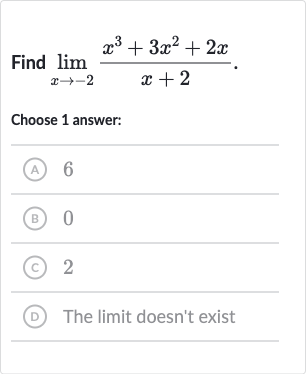Full solution
Q. Find .Choose answer:(A) (B) (C) (D) The limit doesn't exist
- Check for Indeterminate Form: Identify if direct substitution of into the function gives an indeterminate form.Let's substitute into the function and see what we get.This is an indeterminate form, so we cannot simply substitute to find the limit.
- Factorize the Numerator: Factor the numerator to simplify the expression.We notice that the numerator is a polynomial that can be factored. Let's try to factor it.Now, let's factor the quadratic part of the expression. can be factored into .So the entire expression becomes:
- Cancel Common Factor: Cancel out the common factor from the numerator and the denominator.We have a common factor of in both the numerator and the denominator. Let's cancel it out.After canceling out the common factor, we get:
- Final Direct Substitution: Now that we have simplified the expression, let's try direct substitution again. = =

